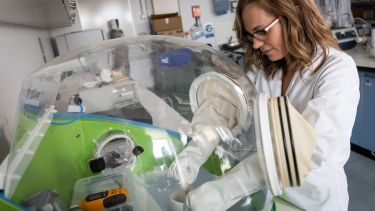Recreating the Chernobyl Elephant Foot in the lab
University of Sheffield engineers have developed materials that could be used to help decommission the Chernobyl and Fukushima nuclear power stations
The materials, created in collaboration with colleagues in Ukraine, simulate Lava-like Fuel Containing Materials (LFCMs) – hazardous substances left behind by a nuclear meltdown
New research is the first time a close approximation of a real LCFM has ever been achieved
Development paves the way for the safe analysis of hazardous materials left behind at Chernobyl and Fukushima

While the public's interest in Chernobyl has been piqued by the recent eponymous HBO/Sky miniseries, the NucleUS Immobilisation Science Laboratory (ISL) in the Department of Materials Science and Engineering has been supporting decontamination and decommissioning efforts for several years, with particular focus on the high profile accidents both at Chernobyl and at Fukushima in Japan.
The result of both accidents was a nuclear meltdown, where overheating causes the core materials to melt leading to partial or total collapse of the core. Collapse leads to radioactive nuclear fuel materials mixing with cladding and other building materials, making it practically impossible to remove it, and these radioactive materials, if left untreated, could find their way outside of the reactor and into the environment. In the case of the Chernobyl disaster, the mix of molten fuel, cladding, steel, concrete and sand formed nearly 100 tonnes of glass-like lava, flowing through the building and solidifying in large masses.
This clearly presents a highly dangerous risk to personnel, wildlife and the environment in the surrounding area, and will remain a hazard for decades, if not centuries, to come, unless something can be done to contain, stabilise or treat the materials. However, removing them is made even more difficult because no one knows what they look like -- relatively few samples of meltdown materials are available for study, and their analysis is made challenging due to the radiation hazard associated with handling them.
Dr Claire Corkhill, who leads the team investigating these materials, said: “Understanding the mechanical, thermal and chemical properties of the materials created in a nuclear meltdown is critical to help retrieve them, for example, if we don’t know how hard they are, how can we create the radiation-resistant robots required to cut them out?”
In work recently published by ISL, in collaboration with colleagues in the Ukraine, researchers have reported the development of materials that have the potential to be used to simulate decommissioning operations in nuclear reactors post-accident.
Small batches of low radioactivity materials, containing depleted uranium only, were developed in the lab to simulate 'Lava-like Fuel Containing Materials' (LFCMs), and were found to be a very close approximation to the microstructure and mineralogy of real LFCM. This is the first time that a close approximation to real LFCM has been achieved.
These simulated materials were then used to analyse the thermal characteristics and corrosion kinetics of LFCM, with results that are very close to those of real LFCM samples collected in a sampling mission inside the reactor, made by scientists in 1991. The study of the corrosion behaviour is vital to support ongoing decommissioning efforts – both at Chernobyl and also at the Fukushima Daiichi Nuclear Power Plant, where LFCM-type materials are thought to have formed, and remain submerged in water used to cool the melted core. As water is removed from the LFCM surfaces, dust forms which is potentially highly radioactive, and could easily find its way into the ecosystem.
Dr Corkhill added: “The major difficulty in understanding the real materials is that they are too hazardous to handle and, although the Chernobyl accident happened over 33 years ago, we still know very little about these truly unique nuclear materials.
“Thanks to this research, we now have a much lower radioactivity simulant meltdown material to investigate, which is safe for our collaborators in Ukraine and Japan to research without the need for radiation shielding. Ultimately this will help advance the decommissioning operations at Chernobyl and also at Fukushima too.”
The investigation into the corrosion behaviour, using the powerful microscope at Diamond Light Source is just beginning, but having established a starting point, the research team hope to advance this work quite rapidly.
So what next? Well, the ability to simulate less hazardous materials in small batches means that further analysis can be carried out safely, and significantly more affordably, with the prospect of advances in understanding of the meltdown material being made more quickly. It also means that large-scale nuclear accident demonstrator facilities, such as the VULCANO facility in France, can be used just for the most important, and safety critical experiments. And beyond that, the long term objective is to identify a procedure to safely remove and contain the hazardous materials present at the disaster sites of Chernobyl and Fukushima.
The research paper, Synthesis, characterisation and corrosion behaviour of simulant Chernobyl nuclear meltdown materials, is published in Nature Materials Degradation. To view the paper, visit: https://www.nature.com/articles/s41529-020-0108-z

